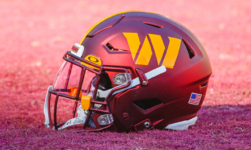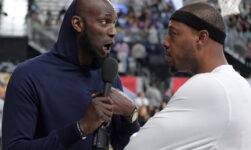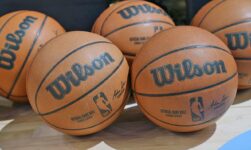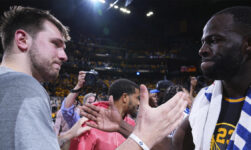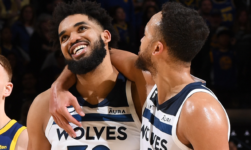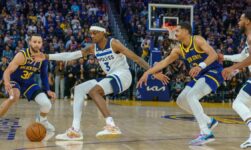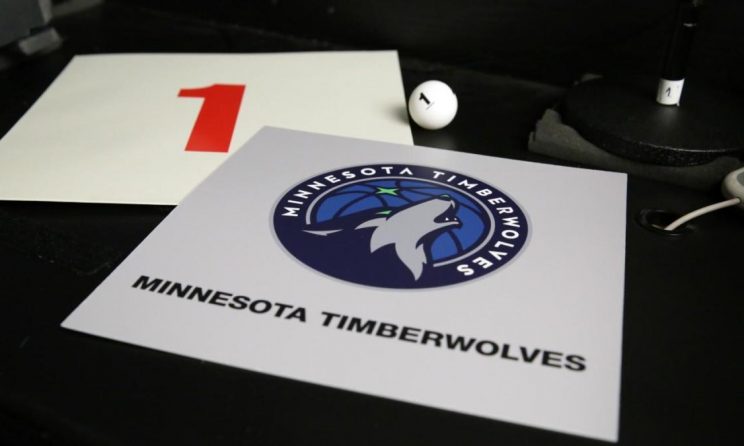
The unusual structure of this year’s rookie class is going to create a somewhat unique 2020 NBA Draft. Typically, upside is prized above all else and teams gamble on the prospects likeliest to become superstars. There might not be a single prospect of that caliber in this entire draft. It’s a class filled with high-floor long-term starters at almost every position. Few of them will materially change a franchise’s fortunes, but many will contribute to winning at some point in their career. They just need to land with the right team.
The lack of stars in this year’s crop makes it far likelier than usual. More teams than ever are going to draft based on need without the option to go big-game hunting, so as the NBA Draft approaches, let’s go over what each team actually needs based on the current construction of their rosters.
Draft picks owned: 6, 50
Needs: Perimeter defense, backup point guard, shooting
The Hawks stocked up on 3-and-D wings in the 2019 NBA Draft, but neither Cam Reddish nor DeAndre Hunter quite proved themselves as long-term cornerstones. Another swing on that archetype could help offset Trae Young’s weaknesses on defense. On offense, he is so impactful that the Hawks fall off of a cliff whenever he sits, so finding a viable backup behind him is essential if Atlanta wants to win next season. Despite his reputation, the Hawks had the lowest 3-point percentage in the NBA last season at 33.3 percent, so more shooting is a necessity.
Potential fits: Tyrese Haliburton, Isaac Okoro, Devin Vassell
If Haliburton is around at No. 6, he could be the perfect fit for Atlanta’s needs. He’s long and athletic enough to grow into a stout perimeter defender, and has the ability to both play alongside Young and fill in the back-up point guard minutes. If you’re not as concerned with offense, Okoro is arguably the best perimeter defender in the draft and should be effective in a transition-heavy offense. Vassell is built in the more traditional 3-and-D mold, and has more upside than some of the other prospects with similar profiles, though No. 6 may be a bit high for him. – Colin Ward-Henninger
Draft picks owned: 14, 26, 30, 47
Needs: Center, shooting, wing depth
Bam Adebayo roasted the Celtics in the Eastern Conference Finals, and deep down, Danny Ainge probably knows Daniel Theis wouldn’t have been close to enough against Anthony Davis, either. Boston needs a long-term starting center, and it needs to offset that player’s presumptive shooting weakness with spacing elsewhere, as the Celtics are used to playing with a big man that provides that himself. Jaylen Brown and Jayson Tatum are stars, but Boston could use a bit more long-term insurance at forward given the uncertainty involved in Gordon Hayward’s future.
Potential fits: Saddiq Bey, Precious Achiuwa, Josh Green
At 6-8 with a 6-10 wingspan, Bey could be the best 3-and-D prospect in the draft, and is certainly one of the most NBA-ready. He could provide depth for the Celtics’ wing rotation that was desperately thin with Hayward injured in the postseason. Starting-caliber centers will be hard to come by in this draft, but Achiuwa is a high-floor option as an athletic shot-blocker with a 7-2 wingspan and lots of room to grow offensively. Green, a 6-5 versatile wing who can shoot and defend, would be a good target for one of the Celtics’ lower first-round picks. – Ward-Henninger
Draft picks owned: 19, 55
Needs: Perimeter defense, passing, front-court versatility
Kevin Durant is the only perimeter rotation player guaranteed to be on next season’s roster that has consistently been a positive defensively, and he’s coming off of a torn Achilles. The Nets need a stopper, and they need someone to offset Kyrie Irving’s ball-dominance. In Cleveland, that was LeBron James. Durant won’t be able to set up teammates as well as LeBron did, but someone in Brooklyn will need to carry that burden. Both of Brooklyn’s centers are best-suited to drop coverage. A big man that could switch or at least effectively hedge on the perimeter would provide sorely needed schematic versatility.
Potential fits: Patrick Williams, Elijah Hughes, Precious Achiuwa
Williams fits the bill as a tenacious perimeter defender, and his 6-11 wingspan could even allow him to steal some minutes at center if the Nets want to go small. It might be a stretch to think Williams will be available at No. 19, so Hughes could be a good wing target with his shooting, playmaking ability and defensive potential. Achiuwa is one of the few bigs in this draft who could be able to switch pick-and-rolls consistently, so the Nets should take a hard look at him if that’s a top priority. – Ward-Henninger
Draft picks owned: 3, 32, 56
Needs: Center, wing, overall talent
More than anything, the Hornets need good players. Terry Rozier and Devonte’ Graham are viable starters, but not remotely good enough to warrant passing on a franchise-altering guard if one is available. The Cody Zeller era is drawing to a close, and the Hornets haven’t developed a replacement. P.J. Washington should be a long-term starter, but Miles Bridges hasn’t popped quite yet. Better defense out of the forward spots should be a priority.
Potential fits: James Wiseman, Anthony Edwards, LaMelo Ball
The consensus is that Ball, Edwards and Wiseman will be the top three picks of the draft in some order, so the Hornets will be happy to end up with one of them. Wiseman fills the center need with perhaps the most upside in the entire draft if he continues to develop his shooting and playmaking skills. Edwards is an immediate bucket-getter with two-way potential, and many believe Ball will end up being the best player in the draft (though I’m not one of them). The Hornets need overall talent, and they’re guaranteed to get it in one of these players — what happens afterward is where the question marks come in. – Ward-Henninger
Draft picks owned: 4, 44
Needs: Passing, perimeter defense, rebounding
Zach LaVine and Coby White both function as scorers more than primary ball-handling types. In the long-run, one of them is probably going to be replaced by more of a point guard. Neither plays much defense. Kris Dunn does, but he’s limited by his size and is a restricted free agent. A forward-size defender to fill the role envisioned for Otto Porter Jr. would help. So would some rebounding. Chicago had the third-worst rebounding rate in basketball. The Lauri Markkanen-Wendell Carter Jr. frontcourt has other virtues, but it probably won’t ever be particularly effective on the glass.
Potential fits: Tyrese Haliburton, Deni Avdija, Onyeka Okongwu
Haliburton is a versatile wing who can play the point or off the ball, making him a good fit next to LaVine and White. Given his combination of size and playmaking ability, Avdija would be an excellent fit, and he’s been rumored as a Chicago target at No. 4. He may not profile as an elite defender, but his international experience makes him at least somewhat familiar with NBA coverages. Okongwu might be the best defensive big in the draft given his combination of rim protection and perimeter containment, and he would also help the Bulls’ rebounding issues. – Ward-Henninger
Draft picks owned: 5
Needs: Perimeter defense, shooting, passing
Cleveland doesn’t have much defensively, but the front-court trio of Andre Drummond, Tristan Thompson and Larry Nance Jr. was at least passable. The same can’t be said on the perimeter. Cleveland was near the bottom of the league in 3-point volume and efficiency, and that came with a disinterested Kevin Love firing away on a career-high seven 3-pointers per game. They need younger shooting to replace him, and if they want to milk any value out of his bad contract, they’ll need some ball-movement. Love’s feelings on Collin Sexton’s ball-hogging are quite clear.
Potential fits: Deni Avdija, Isaac Okoro, Killian Hayes
These are three very different players, but the Cavs need help all over the court, as Sam pointed out. Avdija would provide a playmaker from the wing position who has shown tremendous improvement as an outside shooter. Okoro is the lock-down perimeter defender that Cleveland sorely lacks, but has plenty of offensive question marks. The 6-foot-5 Frenchman Hayes is another point guard, but his best skill is creating for teammates — particularly out of the pick-and-roll — where neither Sexton nor Darius Garland have exhibited significant prowess. – Ward-Henninger
Draft picks owned: 18, 31
Needs: Overall defense, pick-and-roll finisher, secondary shot-creation
Dallas literally had the most efficient offense in NBA history last season. An athletic finisher to replace the injured Dwight Powell would be nice if Willie Cauley-Stein isn’t back, and the Mavericks relied a bit too heavily on Luka Doncic’s ball-handling, but the Mavericks don’t have much need to fix what clearly isn’t broken. The No. 22-ranked defense, however, needs work. Dorian Finney-Smith and Kristaps Porzingis are the only consistently valuable defenders likely to stick around for the long haul, that Maxi Kleber has his moments.
Potential fits: Precious Achiuwa, Isaiah Stewart, Tyrell Terry
Achiuwa and Stewart are both great options to fill the rim protector/pick-and-roll finisher need, with length, strength, athleticism and motor. If the Mavericks really want to double down on their league-best offense, Terry could end up being a great value pick at 18 as an excellent shooter who can play off the ball or operate as a secondary playmaker to Doncic. – Ward-Henninger
Draft picks owned: 22
Needs: Frontcourt depth, shooting, perimeter defense
Projecting Denver’s needs is difficult with four key free agents, but all four of those players (Jerami Grant, Paul Millsap, Mason Plumlee and Torrey Craig) are in the frontcourt, so replacing a potential departure would be advisable. Donovan Mitchell roasted them in the first round before Gary Harris’ return, so at the very least, the Nuggets need a consistent perimeter defender for his bench minutes. A team built around Nikola Jokic’s passing should never finish 26th in 3-point percentage. A marksman could take better advantage of his gifts.
Potential fits: Desmond Bane, Robert Woodard, Josh Green
Denver should have its choice of a few solid wing prospects if they remain at No. 22. Bane should be an NBA-ready spot-up shooter who can also work off screens, but his defense isn’t as much of a sure thing despite his strength. Woodard profiles as a versatile defender at 6-8 with a 7-1 wingspan, and has offensive potential. Green perhaps has the most upside of the three, and could absolutely help the Nuggets on both sides of the ball. – Ward-Henninger
Draft picks owned: 7
Needs: Point guard, overall defense, overall talent
The Pistons may not have a single player on their roster that turns out to be a long-term starter. The goal should be to add as much talent as possible. A primary ball-handler is the single most important piece for a rebuilding team to acquire, and aside from Bruce Brown, the defensive cupboard is bare.
Potential fits: Tyrese Haliburton, Killian Hayes, Kira Lewis Jr.
This is the wrong draft to have the No. 7 pick if you’re looking for a franchise-changing player, but it makes sense to target a point guard given the importance of that position in the modern NBA. Hayes probably has the most potential as a 6-5 playmaker adept in the pick-and-roll, but his floor is lower than that of Haliburton, who could still be on the board. Lewis is an intriguing prospect with his speed and scoring ability, so it might be worth drafting him and hoping that your player development staff can turn him into a De’Aaron Fox type. – Ward-Henninger
Draft picks owned: 2, 48, 51
Needs: Center, wing depth, backup point guard
Shaun Livingston’s retirement opened up a hole behind Stephen Curry, but every decision Golden State makes needs to be based on a presumptive playoff matchup against the Lakers. As it stands, they are woefully ill-equipped to defend LeBron James and Anthony Davis. No rookie is going to take that assignment for an entire series, but perhaps one could contribute to a team effort against arguably the NBA’s two best players. If either can provide the shooting needed to offset Draymond Green’s decline, then all the better.
Potential fits: James Wiseman, Anthony Edwards, Deni Avdija
The Warriors are reportedly not as high on Wiseman as some, but that could be a smokescreen since the fit is undeniable. At worst he’s a lob threat and rim protector, and if his playmaking and shooting evolve he could be the best player in the draft. Edwards would give them an athletic wing who can play alongside the Splash Brothers and provide instant offense. Avdija has long been my favorite fit for Golden State, but it would be a reach to take him at No. 2. They’d be better off trading down if they can get a rotation wing in the process. – Ward-Henninger
Draft picks owned: N/A
Needs: Rebounding, shooting, switchable defenders
It would be easy to say that the Rockets “need” a center, but if they don’t plan to play one, it’s irrelevant. Broadly, they need players who can provide traditional center skills even if they play another position. The Lakers pulled in 64 more rebounds over their five-game series, so improving on the glass would be a nice start. Beyond that, the Rockets need better depth in areas that are already presumably filled. Their house of cards crumbled when Danuel House left the bubble because inferior 3-and-D players need to play real minutes.
Potential fits: Elijah Hughes, Cassius Stanley, Killian Tillie
If the Rockets are going to trade or buy their way into the draft, it will have to be for someone they think can make a real impact, likely in the late-first or second round. Hughes profiles as a great spot-up shooter from the wing, while Stanley would provide tremendous athleticism to help on the boards, with the upside of a lottery pick. Tillie won’t help the rebounding issues much, but he’s a bona fide stretch big at 6-9 who would have an immediate role in Houston. – Ward-Henninger
Draft picks owned: 54
Needs: Wing depth, front-court mobility, shooting
The Pacers don’t have many glaring needs, per se, but they don’t have many overwhelming strengths either. They took the fewest 3-pointers in the NBA last season, but will presumably take more with Nate McMillan out. Some extra spacing might help in that transition. Speaking of transition, the Pacers were 22nd in pace last season and are currently committed to two drop-coverage big men. A more mobile alternative could offer schematic versatility on defense and help facilitate some more fast breaks. Victor Oladipo and Jeremy Lamb are both question marks due to health and Justin Holiday is a free agent, so shoring up the wings will be crucial.
Potential fits: Paul Reed, Tyler Bey, Lamar Stevens
The Pacers will be looking to find gold at the end of the draft, and Reed, Bey and Stevens all fit a similar role as long, versatile defenders with varying degrees of offensive upside. While Bey has the most offensive potential, Reed and Stevens are both capable of playing small-ball center for stretches of the game, which could be an appealing concept for the new-look Pacers. – Ward-Henninger
Draft picks owned: 57
Needs: Point guard, center, shooting
The Clippers lost to the Nuggets in large part because Jokic destroyed Montrezl Harrell. They’ll need a big man who can stand up to him, and they’ll need more of a distributor to spur some ball-movement. The Clippers were 28th in total passes last season, and it made their offense predictable in the playoffs. Ty Lue’s teams tend to shoot far more 3-pointers than Doc Rivers’, so more spacing would be appreciated.
Potential fits: Udoka Azubuike, Nate Hinton, Mason Jones
The Clippers likely aren’t going to find an impact point guard unless they trade up in the draft, so they’ll be best off looking for a big man or shooter in the late-second round. Azubuike can’t guard in space, but he has the strength and physicality to bang with more powerful bigs for limited stretches. He also has a decent post game in addition to being a lob threat and roller. Hinton would provide shooting from the wing, while Jones could be a good fit for the Clippers as a 6-5 combo guard who can run the offense and hit spot-up jumpers. – Ward-Henninger
Draft picks owned: 28
Needs: Ball-handling, perimeter defense, shooting
The Lakers searched high and low for a second-unit point guard at the trade deadline and couldn’t find one. Rajon Rondo filled the role in the playoffs, but he’s a 34-year-old free agent. Someone else will need to fill that role eventually, and when James moves on, become the starting point guard. Cold shooting was a problem for the Lakers throughout the bubble and needs to be addressed this offseason. Kyle Kuzma has improved defensively, but the Lakers probably can’t trust him against the Kawhi Leonards of the world in a playoff setting. Another big wing to preserve LeBron’s energy defensively would help.
Potential fits: Tre Jones, Cassius Winston, Robert Woodard
Jones and Winston are both high-IQ point guards who should be able to step in and run the offense for the world champs right away — it doesn’t hurt that they’re they type of players LeBron James has clamored for in the past. Woodard should be an excellent, versatile perimeter defender, and his ceiling only rises if he can consistently knock down 3-pointers (he shot 43 percent on 70 attempts his last season at Mississippi State). – Ward-Henninger
Draft picks owned: 40
Needs: Shooting guard, shooting, perimeter defense
The Grizzlies think they have four of their five long-term starting slots filled. Ja Morant, Jaren Jackson Jr. and Brandon Clarke are sure things. Justise Winslow’s health means that he isn’t, and as he’s the presumptive stopper of this group, an insurance policy is important. Dillon Brooks has held the shooting guard spot of late, but his erratic play in the bubble might have cost the Grizzlies a playoff spot. A long-term upgrade is in the cards here. Ideally, that player can shoot. Morant needs as much space as possible to offset his own shooting issues.
Potential fits: Skylar Mays, Sam Merrill, Cassius Stanley
There should be some decent shooting guard prospects available by the time the Grizzlies pick. Mays has NBA-ready strength, and is a creative scorer with an improving 3-point stroke. Merrill profiles as an elite, knock-down shooter, but comes with questions on the defensive end. While not as known of a commodity as the other two, Stanley could be the better two-way player when all’s said and done, with a bit more size and a whole lot more athleticism. – Ward-Henninger
Draft picks owned: 20
Needs: Ball-handling, perimeter defense, backup center
The Heat, like the Nuggets, are difficult to project given their own free agents, but they could use another young ball-handler to develop either behind or alongside Goran Dragic. Kendrick Nunn’s limitations were on full display in the Finals. The Heat were so thin up front that Andre Iguodala and Solomon Hill had to play center when Bam Adebayo sat, so another big man would be helpful as well. If Tyler Herro and Duncan Robinson are going to be mainstays, the Heat are going to have to balance them out with another young defender.
Potential fits: Cole Anthony, Tre Jones, Precious Achiuwa
Anthony is a polarizing prospect so there’s a chance he could go in the lottery, but also a chance he could fall to the Heat at 20, where he’d be a great value pick. Jones is as solid as they come in terms of ball-handling, so he’d fill in the need there perfectly. If backup center is the priority, Achiuwa could fill in a small percentage of what Adebayo does defensively, while providing a lob threat and rim-runner on offense. – Ward-Henninger
Draft picks owned: 24
Needs: Shooting, ball-handling, switchability
The Bucks shot only 32.7 percent from behind the arc in their playoff loss to Miami, and that came with the Heat leaving their shooters wide open to help against Giannis Antetokounmpo. The strategy was predictable. The Bucks finished fourth in 3-point attempts, but 17th in percentage. They need better shooters, and they need better defensive versatility. The Heat solved their drop-scheme, and the Bucks were so uncomfortable switching that they were forced to stick with a broken system. Another long-term ball-handler to develop is a necessity, though if the hole is going to be fixed in time for 2021, the Bucks probably need a veteran.
Potential fits: Aaron Nesmith, Desmond Bane, Grant Riller
Nesmith and Bane are both wings who will provide the shooting the Bucks need, though their defensive capabilities may leave something to be desired, at least initially. If Milwaukee is looking for another ball-handler, Riller is more than capable, and can also provide an extra scoring punch as a shooter and with his penetration. At 23, he should be more ready to contribute than other guards in the draft, perfect for a win-now team like the Bucks. – Ward-Henninger
Draft picks owned: 1, 17, 33
Needs: Overall defense, shooting, talent
The Timberwolves are built around two players on max contracts that can’t defend. At all. Josh Okogie is the only above-average defender still on the roster. There is a real chance that Minnesota has the worst defense in an NBA that still includes the Washington Wizards next season. They need to find a possible defensive cornerstone, and he needs to have star-caliber upside, because without a first-round pick next season and devoid of long-term cap flexibility if they re-sign their restricted free agents, the Wolves may not have another chance to find a third banana before Karl-Anthony Town’s hits free agency. If you thought Milwaukee’s shooting disparity was bad, just look at Minnesota’s: the Timberwolves shot the third-most 3-pointers in basketball, but were 28th in 3-point percentage. Their midseason additions should help on that front, but if either Malik Beasley or Juancho Hernangomez leaves, the Timberwolves need to replace them. Either way, given their system and two stars, 3-and-D prospects should be prioritized.
Potential fits: LaMelo Ball, Anthony Edwards, Isaac Okoro
The Timberwolves were surely happy to secure the top pick in the draft, but there is no clear selection given their needs. Two of the most talented prospects, LaMelo Ball and James Wiseman, play the same positions as their two franchise players, D’Angelo Russell and Karl-Anthony Towns, so that leaves Edwards as the most logical pick as a wing scorer with the potential to become their third star. Defensively, however, Edwards could be a negative on a team that can’t afford it. If that’s the case, they may want to trade down for Okoro, who will be an immediate defensive contributor and has room to grow offensively. They could ultimately choose to just take the most talented player, and many believe that’s Ball. – Ward-Henninger
Draft picks owned: 13, 39, 42, 60
Needs: Frontcourt shooting, ball-handling, perimeter defense
Zion Williamson needs a frontcourt partner that can shoot. Playing him with another non-shooting big man, especially with Lonzo Ball around, just cramps the floor too much. Whether or not Ball sticks around, at this point, it seems safe to say that he isn’t a primary ball-handler in a halfcourt setting. He still has several uses on a good team, but the Pelicans need a more traditional pick-and-roll guard. Jrue Holiday fits that description to an extent, but he doesn’t fit Williamson’s timeline and may get traded. If he is, the Pelicans desperately need to replace his defense if they plan to win next season.
Potential fits: Deni Avdija, Saddiq Bey, Patrick Williams
Avdija may be long gone by the time the Pelicans pick at 13, but he potentially fills their need for both frontcourt shooting and ball-handling. If he’s gone, Bey is a prototypical 3-and-D prospect who, at 6-8, can certainly play four when Zion is at the five. Williams is a versatile defensive wing who also profiles as a four, but there are more questions about his shooting ability. – Ward-Henninger
Draft picks owned: 8, 27, 38
Needs: Shooting, point guard, talent
The Knicks have two core pieces right now: RJ Barrett and Mitchell Robinson. The plan should be to build around them. Neither can shoot from behind the arc, so spacing is a priority. Neither are particularly strong passers, so a point guard that can set both them and teammates up is needed as well. But neither Barrett nor Robinson appear to be on a star trajectory at the moment. If the opportunity to find a player with that potential presents itself, the Knicks should pursue it.
Potential fits: LaMelo Ball, Killian Hayes, Deni Avdija
If there were ever a prospect built to play in New York, it’s LaMelo Ball, but the Knicks’ new leadership might not be as willing to sacrifice assets to trade up to get him. If they stick with the No. 8 pick, Hayes is an intriguing point guard prospect who could end up being better than Ball if he continues to develop, but has a much lower floor. Avdija can provide point-guard skills from the forward position, while potentially providing space for Barrett and Robinson with his improving shooting. – Ward-Henninger
Draft picks owned: 25, 53
Needs: Shooting, passing, talent
The Thunder look like they’re headed for a rebuild, so the priority for now will be asset accumulation. Shai Gilgeous-Alexander looks like a future All-Star, but he’s an underwhelming shooter who will need space to operate. The likely exit of Chris Paul creates a ball-movement vacuum. Gilgeous-Alexander is a fine passer, but it wouldn’t hurt the Thunder to give him another ball-handler to work off of as he did Paul. That arrangement worked well for Oklahoma City last season.
Potential fits: Cole Anthony, Tyrell Terry, Leandro Bolmaro
Anthony will probably be long gone by 25, but he’d be a great target if he slips for any reason with his scoring and playmaking abilities. Terry has the potential to be a sleeper in this draft, with tremendous scoring upside given his ability to shoot off the dribble. Since the Thunder appear to be in no hurry and have lots of upcoming draft picks, they might opt to draft Bolmaro, a slashing 6-7 wing who should thrive in transition but needs time to develop, either in the NBA or overseas. – Ward-Henninger
Draft picks owned: 15, 45
Needs: Ball-handling, shooting, rim-protection
Unless you’re exceedingly confident in Markelle Fultz, the Magic are entering yet another offseason without someone capable of running their offense. The point guards they do have never have room to operate because of Orlando’s underwhelming spacing. Jonathan Isaac is recovering from a torn ACL, and the Magic aren’t well-equipped to protect the basket while he’s out unless Mo Bamba turns things around. Nikola Vucevic has his virtues, but he’s not exactly Rudy Gobert.
Potential fits: Cole Anthony, Tyrese Maxey, Saddiq Bey
If the Magic opt for a point guard at No.15, they should have some solid options between Anthony, Maxey and maybe Kira Lewis Jr. if he’s still around. You can also never go wrong by taking a big, 3-and-D wing in today’s game, and Bey is one of the best in the draft.
Draft picks owned: 21, 34, 36, 49, 58
Needs: Shooting, ball-handling, athleticism
Philadelphia has the same basic problems as Milwaukee. They don’t have anyone capable of running the offense down the stretch, and even if they did, the Ben Simmons-Joel Embiid pairing shoots so poorly that such a player might not matter anyway. The 76ers need to reinvent their offense, and that starts with a legitimate point guard. Ideally, that player can shoot. That would help their halfcourt offense, but their transition attack needs work as well. The 76ers finished 20th in pace despite having Simmons. A few more athletes off the bench might help spur some extra fast breaks, though with Embiid in place, it’s unclear how fast Philadelphia can feasibly play.
Potential fits: Grant Riller, Tyrell Terry, Elijah Hughes
The 76ers have options if they’re looking for a point guard at No. 21, where Riller and Terry could still be on the board. Riller is older and a more polished scorer, while Terry has a higher upside but could need time to develop. Hughes might be the answer the Sixers are looking for in that he’s big (6-6), he can shoot and he can be a secondary playmaker when needed. – Ward-Henninger
Draft picks owned: 10
Needs: Point guard, overall defense, backup center
Ricky Rubio is 30 and has a history of injuries. The Suns need someone on Devin Booker’s timetable, and ideally, that player can shoot. Even if Rubio is back as the starter, Cameron Payne probably isn’t a viable long-term backup. Speaking of backups, both Aron Baynes and Dario Saric are bound for free agency, and if the Suns want to aggressively target a guard (Fred VanVleet), that could mean renouncing their rights to one or both. That creates a hole at backup center. Mikal Bridges is headed for defensive stardom and DeAndre Ayton has grown considerably on that end of the floor, but Booker’s limitations on that end of the floor create the need for a bit more help.
Potential fits: Kira Lewis Jr., Tyrese Maxey, Devin Vassell
Point-guard hunting at No. 10 should provide ample choice for the Suns, with Lewis and Maxey likely being the top options on the board at that time. They’re both quick and strong in the pick-and-roll, but Lewis probably has more potential as a shooter. If they elect to go with defense, Vassell profiles as a lockdown defender with room to grow on offense, much like Bridges. – Ward-Henninger
Draft picks owned: 16, 46
Needs: Small forward, backup center, overall defense
The Blazers entered last season without a small forward-sized player on their roster. Their solution to that was acquiring 35-year-old Trevor Ariza, who skipped the bubble, leaving Carmelo Anthony and Gary Trent Jr. the unenviable task of defending LeBron in the playoffs. It didn’t go well, and if Portland wants to have any chance at changing that next season, it needs an actual small forward athletic enough to hang with the best of the West. Hassan Whiteside is a free agent, and if he leaves, Portland will need someone to spell Jusuf Nurkic. Their defensive struggles in the bubble speak for themselves. They won’t make the playoffs giving up 120 points per 100 possessions, and Damian Lillard and C.J. McCollum aren’t helping much on that end of the floor. Every other spot in the lineup needs to be stout to make up for them.
Potential fits: Devin Vassell, Saddiq Bey, Patrick Williams
Recent videos of Vassell’s revamped (not in a good way) shooting form might allow him to drop to Portland at No. 16, where they’ll happily snatch him up due to his defensive potential. If he’s gone, one of Bey or Williams might still be around, and they’re excellent consolation prizes. Bey is more of a finished product while Williams has more upside, but both should immediately help a team desperate for wing defenders.
Draft picks owned: 12, 35, 43, 52
Needs: Center, overall defense, athleticism
Richaun Holmes filled the center spot admirably last season, but he’s a fill-in, not a long-term starter. The Kings allowed opponents to make 70.8 percent of shots within three feet of the rim—the worst figure in basketball last season. They struggled nearly as much on the boards. Marvin Bagley may help on that front, but he’s still a defensive negative at this point. The Kings almost overcame that in the 2018-19 season through speed, yet they dropped from third to 19th in pace under Luke Walton last season. Don’t overthink this. De’Aaron Fox is a nightmare in transition. Surround him with athletes that can run the floor and watch the points pile up.
Potential fits: Devin Vassell, Patrick Williams, Jalen Smith, Daniel Oturu
The Kings are probably better off looking for athletic, defensive wings at No. 12 and then going center-hunting with their second-round picks. If that’s the case, Vassell and Williams could be options with the lottery pick, while Smith and Oturu, two athletic rim protectors with offensive upside, would be solid picks if they fall to the second round. – Ward-Henninger
Draft picks owned: 11, 41
Needs: Shooting, overall defense, forward
The Spurs have always made up for low 3-point volume with high efficiency, but that may no longer be possible. Their best shooter, Bryn Forbes, is a free agent, and their next two, LaMarcus Aldridge and Patty Mills, are on expiring contracts in their 30s. The Spurs need younger shooters to put around their up-and-coming ball-handlers. Speaking of Aldridge, one way or another, his time as a Spurs star is drawing to a close. San Antonio needs a long-term replacement for him at power forward and for Rudy Gay at small forward. The Spurs finished 20th in defense last season, and many of their veterans are at the end of their rope. The Spurs need some defensive size to pair with the promising Derrick White-Dejounte Murray duo.
Potential fits: Deni Avdija, Devin Vassell, Saddiq Bey
The Spurs aren’t used to picking in the lottery, but their track record in the draft speaks for itself. Avdija is a Spursy, high-IQ player, but they’ll be extremely fortunate if he falls to No. 11. Instead, they’ll likely have their pick of the 3-and-D crop led by Vassell, Bey, Patrick Williams and Aaron Nesmith. Then again knowing the Spurs, they could go way off the board and take a projected second-rounder in the lottery, in which case the rest of the league better watch out. – Ward-Henninger
Draft picks owned: 29, 59
Needs: Center, guards, one-on-one scoring
The playoffs proved somewhat definitively that Pascal Siakam is not capable of leading a crunchtime offense yet. Finding someone who is at 29 is pretty ambitious, but a home run swing on a one-on-one scorer as a developmental fallback plan makes some sense. In more immediate terms, both of Toronto’s big men are free agents. Marc Gasol and Serge Ibaka are nearing the end anyway, so a young center to occupy the role once held by Jakob Poeltl would be nice. The point guard position was a strength last season, but Kyle Lowry is 34 and Fred VanVleet is a free agent. Whether he stays or goes, it’s time for the Raptors to start considering a succession plan for Lowry.
Potential fits: Grant Riller, Cassius Stanley, Daniel Oturu
Riller is an advanced one-on-one scorer at the point guard position who, at 23, is more ready than others to contribute on a championship-caliber team. If Masai Ujiri and Co. really want to swing for the fences, Stanley may be the move at No. 29. The Duke product has freakish athleticism and looks like just the type of player who would benefit from the NBA style compared to college. If the Raptors decide to go for a backup center, Oturu fits the bill as a rim protector, though he’ll need to improve his lateral quickness in order to not get killed in pick-and-roll defense. – Ward-Henninger
Draft picks owned: 23
Needs: Perimeter defense, point guard, overall bench production
Jamal Murray did to Utah what Donovan Mitchell did to Denver, but unlike the Nuggets, the Jazz didn’t have a Gary Harris waiting in the wings to turn the tide. They went all in on offense last season hoping that Rudy Gobert would be enough on defense. Clearly, he wasn’t. Mike Conley might have helped on that front, but his decline across the board was substantial, and unless the Jazz want Mitchell playing point guard for the long haul, they need to start looking for his next backcourt partner. Despite Conley’s issues, Utah’s starters were mostly effective. Their bench, ranked 23rd in scoring and disastrous defensively, ultimately sunk them. They had six consistently effective players last season, and one of them missed the bubble due to injury. That number has to reach at least eight next season, maybe nine.
Potential fits: Josh Green, Tyrell Terry, Malachi Flynn
Green has the potential to be a lock-down defender, and is already a capable spot-up shooter who could become much more dynamic offensively with work. If the Jazz want a young backcourt mate for Mitchell, Terry is one of the most exciting offensive prospects who might be around at No. 23, while Flynn is a solid scorer, playmaker and defender but is a bit undersized. – Ward-Henninger
Draft picks owned: 9, 37
Needs: Overall defense, point guard, rebounding
If the season had ended before the bubble, the Wizards would have been only the second team this century to allow 115 points per 100 possessions. Their defense needs to be torn down and rebuilt from the ground up. So does their league-worst rebounding. John Wall is expected to return to the lineup next season, but athleticism-reliant point guards coming off of torn Achilles tendons tend not to regain their former glory. The Wizards need to begin seeking out a long-term replacement.
Potential fits: Isaac Okoro, Onyeka Okongwu, Kira Lewis Jr.
Okoro seems to be the perfect fit to help the Wizards’ hapless defense and rebounding. Okongwu likely won’t slide to No. 9, but he’d be an excellent foundation for any defense given his shot-blocking and ability to switch onto guards. If Washington is looking for a Wall replacement, Lewis fits the mold as a lightning-quick point guard who is a better scorer, but not as good of a distributor as Wall at the same stage of development. – Ward-Henninger

